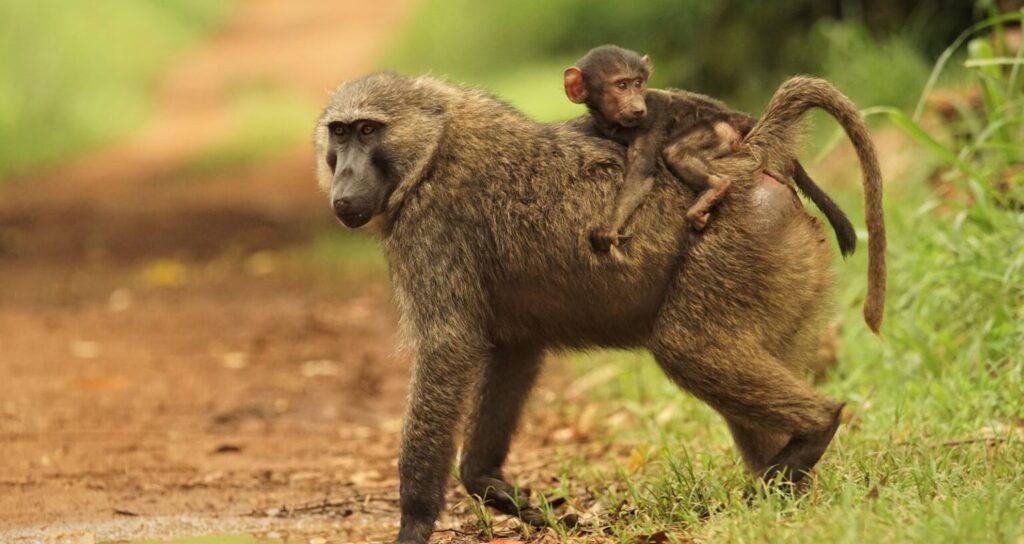Facts About Baboons, Types, size, appearance, Where to see,
Facts About Baboons, Baboons are primates and are among the largest in the world. Olive, yellow, chacma, Guinea, and holy baboons inhabit diverse environments across Africa and Arabia. The olive baboon is the predominant species within the baboon family. Primates tours in Uganda or gorilla trekking safaris will enable you to observe baboons in their natural environments, along with other primate species such as chimpanzees in Kibale National Park, Budongo Forest, Kalinzu Forest, and Kyambura Gorge in Queen Elizabeth National Park, as well as the elusive mountain gorillas in Bwindi Impenetrable and Mgahinga Gorilla National Parks.

The baboon, like to other Old World monkeys, does not possess a prehensile tail, rendering it incapable of functioning as a hand; yet, it retains the ability to climb when required. All possess sharp canine dentition, pronounced nasal structures, and thick fur. Male specimens possess an elongated mane that encircles their neck, known as a ruff.
What is the look of baboons?
Baboons possess elongated, canine-like muzzles, robust, muscular jaws equipped with sharp canine teeth, closely spaced eyes, dense fur except on their muzzles, abbreviated tails, and ischial callosities, which are hairless, insensate skin pads on their protruding buttocks that enhance sitting comfort. Male hamadryas baboons possess a prominent white mane. Baboons have sexual dimorphism in size, coloration, and/or the development of canine teeth.
Types of Baboon.
Baboons are classified into six species: the hamadryas baboon, the Guinea baboon, the olive baboon, the yellow baboon, the Kinda baboon, and the chacma baboon. Each species is indigenous to one of Africa’s six regions, with the hamadryas baboon originating from a part of the Arabian Peninsula. Baboons have existed for a minimum of two million years and are the largest non-hominid primates.
What is the size of baboons?
Baboons exhibit variations in size and weight according on the species. The Kinda baboon is the smallest, reaching 50 cm in height and weighing 14 kg, but the Chacma baboon may have a length of 120 cm and a weight of 40 kg.
Baboons are diurnal and terrestrial, migrating throughout the day, while seeking refuge from predators at night in trees, elevated cliffs, or on rocky outcrops. They can be located across Africa in savannahs and woods. They ingest grasses, seeds, roots, leaves, bark, assorted fruits, insects, fish, shellfish, rodents, birds, vervet monkeys, and little antelopes.
Their primary predators consist of Nile crocodiles, leopards, lions, and hyenas. Baboons predominantly inhabit hierarchical groupings characterized by harems. Baboons may discern individual dominance relationships through vocal communications.
Generally, every male can copulate with any female; nevertheless, the social status of the males affects their mating hierarchy. Females generally deliver a single offspring following a six-month gestation period. mothers frequently serve as the principal caregivers for their offspring; however, numerous mothers may also distribute the responsibility among all their children. The puppies are weaned after approximately one year.
They attain sexual maturity between the ages of five and eight. Male individuals often depart from their natal group before to reaching sexual maturity, but the majority of females tend to remain within the same group for their whole lives. Baboons in captivity can live for as long as 45 years, although their lifespan in the wild ranges from 20 to 30 years.
The primary predators consist of Nile crocodiles, lions, spotted hyenas, striped hyenas, and leopards. Nevertheless, they are regarded as formidable prey for the leopard, which predominantly targets juvenile baboons. Large males often confront intruders or predators by yawning, displaying their eyes, making gestures, and charging towards them. Although baboons are not considered prey, the black mamba snake has been known to kill them. The inadvertent awakening of the snake by a baboon is a frequent cause of this. Information Regarding Baboons
Uganda possesses one of the greatest populations of baboons globally. Olive baboons can be observed in significant quantities in Budongo Forest during chimpanzee trekking and along the Karuma region in northern Uganda while en route to Murchison Falls National Park. Baboons are also observed in Kenya and Tanzania.
Baboons are experiencing habitat loss due to overgrazing, agricultural expansion, irrigation initiatives, habitat invasion, deforestation, and poaching, especially in countries like the Democratic Republic of the Congo.
Facts About Baboons, It is our responsibility to protect these species by informing our communities about the ecological significance of baboons, preserving their natural habitats, and endorsing anti-poaching efforts.
